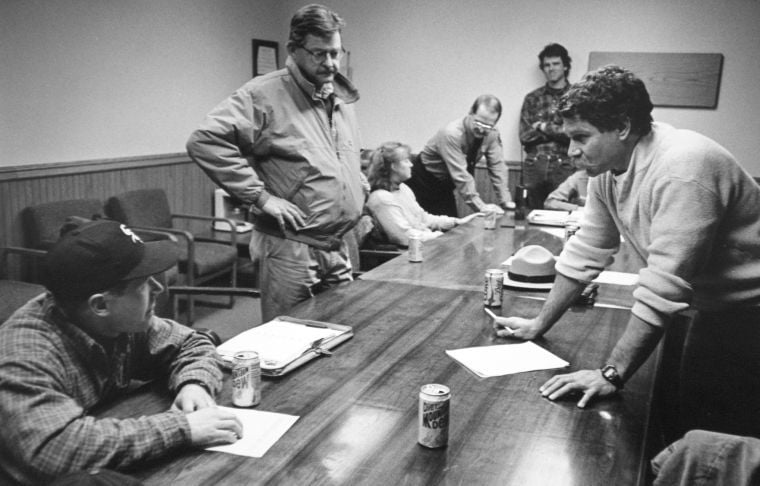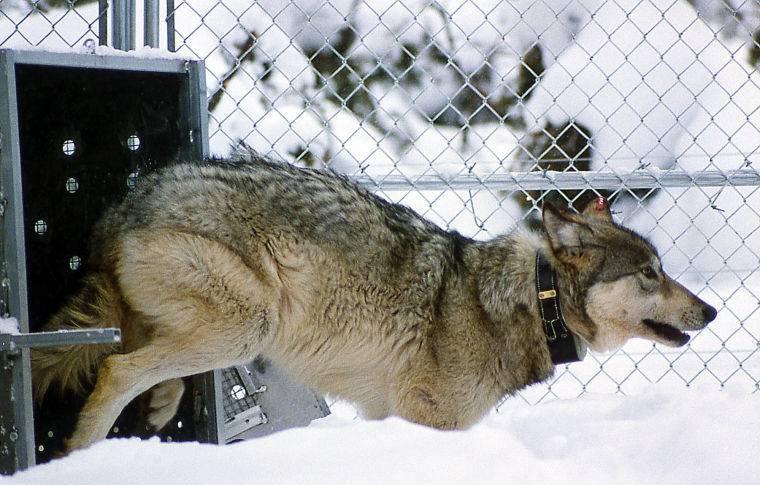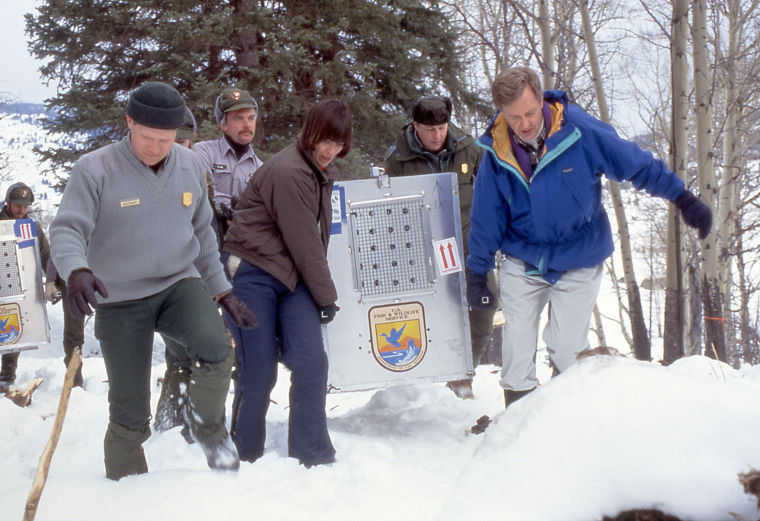Animosity for the species is ‘way down,’ coordinator says.
Posted: Wednesday, January 14, 2015
Mike Phillips, Jim Evanoff, U.S. Fish and Wildlife
Service Director Molly Beattie, Yellowstone National Park Superintendant
Mike Finley and Secretary of the Interior Bruce Babbitt carry the first
crate holding a wolf to the Crystal Bench pen on Jan. 12, 1995, as the
park implemented its wolf reintroduction program.
Two decades ago
this week federal managers released the initial batch of gray wolves
into the Northern Rockies, repatriating a controversial carnivore that’s
since spurred dozens of lawsuits, countless scientific studies and
large doses of delight and indignation.
The action also planted a seed for a regional wolf population that’s grown to nearly 2,000 and become a fixture in the Greater Yellowstone Ecosystem and American West after a decades-long absence last century.
The Wyoming Farm Bureau Federation challenged the reintroduction persistently, even while it was underway. Because of an injunction obtained by the bureau, federal managers were told by the Department of Justice they must keep the wolves confined to the 2-foot-wide, 3-foot-high and 4-foot-long steel shipping crates for 33 hours. At that point the Canadian packs were already being trucked south. Their crates were placed in the Yellowstone pen with the wolves still in them.
On the 20th anniversary of wolf reintroduction, Askins thanked all those involved. “I personally couldn’t be happier and prouder of the success of wolves,” she said. “And I couldn’t be more honored to be a part of the tribe of people that really worked so hard to make the reintroduction happen.
“There were people that will be my heroes for life,” she said. “They were oftentimes really hidden from a lot of the spotlight and all the press. Their work made reintroduction a reality.”
The action also planted a seed for a regional wolf population that’s grown to nearly 2,000 and become a fixture in the Greater Yellowstone Ecosystem and American West after a decades-long absence last century.
In
Yellowstone National Park’s Lamar Valley, where there was a “soft
release” of 14 Canadian wolves into an enclosure, the wolves weren’t
returned to the wild until late March 1995. But the lobos’ presence in
the pens and transport into the park proved to be a spectacle.
Jackson Hole News editor Angus M. Thuermer Jr. reported the reintroduction from the scene.
“Caught in Canada, tranquilized, weighed, injected, tagged, collared, caged, exported, imported and transported, they entered Yellowstone’s north gate in a horse trailer at 8:36 a.m. Thursday,” Thuermer wrote Jan. 18, 1995.
He described his first glimpse. “I
see the fleeting silhouette loping through the woods,” Thuermer
reported. “Wolf. It is the floating nature of the gait, the size of the
head, the erect ears and thick fur that make this animal distinct.
Purposeful and relentless in its stride, it glides in and out of the
trees as it cruises the perimeter of its 1-acre pen at Crystal Creek.”
With
less fanfare and hoopla, 11 wolves were also released beginning that
week in central Idaho in a more abrupt “dump and run”-style of
reintroduction.
Another round of releases followed in 1996, bringing the total number of transported wolves to 66. They thrived, and within five years the wolf population in the Greater Yellowstone had grown to 177 animals in 18 packs.

Yellowstone biologist Mike Phillips talks with chief of research John Varley and ranger Mike Keator late on Jan. 11, 1995, after a court order temporarily blocked release of the first wolves into Yellowstone holding pens. The order was overturned and the wolves were released into the pens the next day.

Yellowstone biologist Mike Phillips talks with chief of research John Varley and ranger Mike Keator late on Jan. 11, 1995, after a court order temporarily blocked release of the first wolves into Yellowstone holding pens. The order was overturned and the wolves were released into the pens the next day.
Their success was wholly expected, said Ed Bangs, the retired U.S. Fish and Wildlife Service wolf reintroduction coordinator.
Bangs and colleagues correctly predicted about a 10 percent annual population growth rate. “People
think they’re like this really timid animal,” Bangs said in an
interview from Helena, Montana. “Wolves are big, bold, adaptable,
resilient large predators. Once
you turned them loose in really good habitat, they did really, really
well,” Bangs said. “It’s not like we were really smart. They are just
really good animals.”
The Wyoming Farm Bureau Federation challenged the reintroduction persistently, even while it was underway. Because of an injunction obtained by the bureau, federal managers were told by the Department of Justice they must keep the wolves confined to the 2-foot-wide, 3-foot-high and 4-foot-long steel shipping crates for 33 hours. At that point the Canadian packs were already being trucked south. Their crates were placed in the Yellowstone pen with the wolves still in them.
The
courts reversed the stay the evening of Jan. 12, 1995, and biologists
“rushed back to open the crates,” according to the Jackson Hole News archives.
At
the time of the release Wolf Fund director Renee Askins had been
advocating for wolf reintroduction for nearly 17 years. In that time
Askins toured around Wyoming and the West trying to sway public opinion. “Our
whole strategy was to try to understand what the specific concerns were
and then to address them literally one by one,” she said in an
interview. “My staff called it ‘behind enemy lines lecture tours.’”

A wolf leaps out of its crate and into the Rose Creek pen in Yellowstone in January 1996 as part of Yellowstone’s reintroduction program. The lobos were allowed to acclimate to the environment in large pens before being released into the wild.

A wolf leaps out of its crate and into the Rose Creek pen in Yellowstone in January 1996 as part of Yellowstone’s reintroduction program. The lobos were allowed to acclimate to the environment in large pens before being released into the wild.
The U.S. Fish and Wildlife Service, meanwhile, studied wolf reintroduction through an environmental impact statement. The feds ended up going with the plan they preferred — establishing “nonessential experimental populations” in Yellowstone and Idaho.
Even with the plan on the table the prospects looked grim, Askins said. “Western
agriculture had been in control of the politics of the West for so long
that no one thought there was a chance in hell it would ever fly,” the
former Moose resident said.
Success, Askins said, was owed to “a lot of people working collaboratively with an enormous amount of information and passion. “Inch
by inch by inch,” she said. “Both politically and logistically, it took
that. It was about changing the culture. It was about engaging the national public in a way that empowered them to want to achieve something.” Askins had pledged to shutter the Wolf Fund once the feat was complete.
Having become accustomed to free meals of road kill, the Yellowstone wolves were at first hesitant to abandon the pens. “It certainly surprises me that they are as tied to the pen as they are,” U.S. Biological Survey wolf expert Dave Meach told the Jackson Hole News. “It shows what happens when you bring animals in from the wild who never knew anything about a pen.” After a week all 14 Yellowstone wolves were on the run in the wild.
In
the 20 years since there’s been no shortage of legal trouble for the
lobo. Since 2011 wolves have been a state-managed, hunted species in
Idaho and Montana, which provide most of their Northern Rocky range.
Jurisdiction
of Wyoming wolves has swung between the state and federal government.
Their Endangered Species Act listing was removed in 2012, but
protections were restored in September.
The political and legal instability aside, Bangs said wolves are doing well. “I
think the state guys have done a really good job,” he said. “By and
large, there are still a lot of wolves, and the wolf population really
hasn’t gone down at all.”
At last official
count there were a minimum of 1,592 wolves in the Northern Rockies
region. That’s down slightly from an apex of 1,749 in 2011, but roughly
double estimates from a decade ago.
Bangs, who retired in 2011, said that in his opinion “animosity is way down” for wolves in the West.
“I think the average person is kind of over it,” he said.
The antics of wolf extremists on both sides of the issue persist, he said. “It
takes two to maintain a dysfunctional relationship,” Bangs said.
“You’ve got the wolf lovers and wolf haters still lobbing grenades. They’re just doing that to torment the other side,” he said, “and it really has no effect on anything.”
On the 20th anniversary of wolf reintroduction, Askins thanked all those involved. “I personally couldn’t be happier and prouder of the success of wolves,” she said. “And I couldn’t be more honored to be a part of the tribe of people that really worked so hard to make the reintroduction happen.
“There were people that will be my heroes for life,” she said. “They were oftentimes really hidden from a lot of the spotlight and all the press. Their work made reintroduction a reality.”
Askins singled out Bob Barbee, then Yellowstone’s superintendent, and John Varley, the park’s chief of research.
source
source



No comments:
Post a Comment